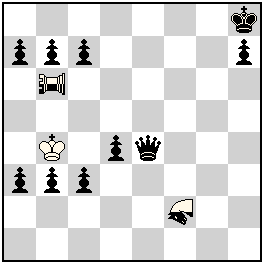| No.345 Julia Vysotska (Latvia) |
Original Problems, Julia’s Fairies – 2013 (II): May – August ?Previous ; ?Next ; ?List 2013(II) Please send your original fairy problems to: julia@juliasfairies.com |
No.345 by Julia Vysotska – Anti-batteries, reciprocal play of neutral PAO/NAO, Take&Make with activity of the white King and black Q! (JV)
Definition:
PAO(PA): Moves as Rook, but captures only by hopping over a hurdle to any square beyond.
NAO(NA): Moves as Leo, but on Nightrider-lines instead of Queen-lines.
Nightrider(N): A Rider along a straight line on squares lying a Knight`s move away from each other.
Take & Make: Having captured, a unit must immediately, as part of its move, play a non-capturing move in imitation of the captured unit from the capture-square. If no such move is available, the capture is illegal. Promotion by capture occurs only when a pawn arrives on the promotion rank as the result of a take&make move. Checks are as in normal chess: after the notional capture of the checked K, the checking unit does not move away from the K’s square.
|
No.345 Julia Vysotska
Latvia
original-06.07.2013
 h#2,5 2 solutions (1+10+2)
Take&Make Neutral Pao b6; Nao f2 Solutions: (click to show/hide)
|



Beautiful modification of the earlier 342. Pity so many black pawns are needed to control the neutral Nao.
Thanks! I agree about black pawns. But the good thing is that just two of them are cook-stoppers! No model mate in (I), but still I’m happy about this setting as it wasn’t easy to find positions for NAO, PAO, wK, bQ.
Really a very good improvement of the idea of earlier problem.(342). Now all the pieces are well utilized in both the solutions. It is good to see that one neutral piece is capturing the other one and WK after capturing BQ and completing the T&M moves controls g7 & g8 differently.
Well done! Congrats!
— SKB
Thank you! I also think that this one is technically better. And the initial setting here was more complicated to find, although it has only one pair of pieces reciprocally playing. Two pairs is the benefit of No.342.
After that I’m amazed how it is possible to have 4 pairs of reciprocally playing pieces as in No.343 by Vlaicu Crișan & Klaus Wenda !
http://pdb.dieschwalbe.de/search.jsp?expression=PROBID=%27P1312003%27